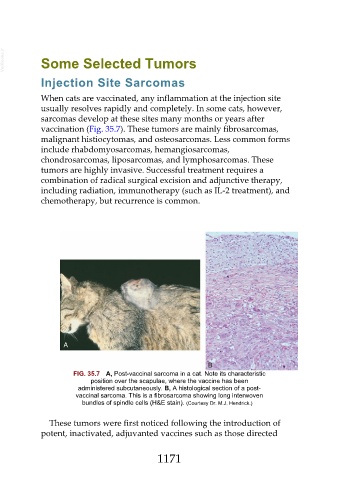Page 1171 - Veterinary Immunology, 10th Edition
P. 1171
VetBooks.ir Some Selected Tumors
Injection Site Sarcomas
When cats are vaccinated, any inflammation at the injection site
usually resolves rapidly and completely. In some cats, however,
sarcomas develop at these sites many months or years after
vaccination (Fig. 35.7). These tumors are mainly fibrosarcomas,
malignant histiocytomas, and osteosarcomas. Less common forms
include rhabdomyosarcomas, hemangiosarcomas,
chondrosarcomas, liposarcomas, and lymphosarcomas. These
tumors are highly invasive. Successful treatment requires a
combination of radical surgical excision and adjunctive therapy,
including radiation, immunotherapy (such as IL-2 treatment), and
chemotherapy, but recurrence is common.
FIG. 35.7 A, Post-vaccinal sarcoma in a cat. Note its characteristic
position over the scapulae, where the vaccine has been
administered subcutaneously. B, A histological section of a post-
vaccinal sarcoma. This is a fibrosarcoma showing long interwoven
bundles of spindle cells (H&E stain). (Courtesy Dr. M.J. Hendrick.)
These tumors were first noticed following the introduction of
potent, inactivated, adjuvanted vaccines such as those directed
1171

